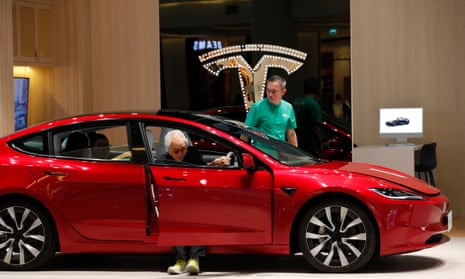Extract from The Guardian

The Tesla Model 3 is one of the most popular models of EV available in Australia. EVs are ‘a core part of everyday Australian lives,’ the Electric Vehicle Council says.
EVs represent about 1% of light vehicles in Australia – but Electric Vehicle Council warns there is ‘more work to be done’ to reach 2050 emissions targets.
Fri 15 Mar 2024 01.00 AEDT
Last modified on Fri 15 Mar 2024 07.48 AEDTElectric vehicles are “no longer a novelty” and their uptake in Australia is booming, with the industry recording a 120% rise in sales over the past year, according to a new report on the industry.
There are now more than 180,000 EVs on Australian roads, with 98,436 of those bought last year, the Australian Electric Vehicle Industry Recap 2023 found.
The Electric Vehicle Council and University of Sydney report, released on Friday, also showed that charging infrastructure locations increased by 75% on the previous year, with 812 charging stations now in place across Australia.
Bolstered by government policy encouraging EV use, the Australian Capital Territory leads the national EV market, with EVs accounting for more than 20% of all new vehicles sold.
New South Wales’ EV sales growth was 9%, followed by Queensland – which has the most generous EV rebate scheme in Australia – at 8.3%, and Victoria at 8%. While comparatively low, EV sales in the Northern Territory tripled in 2023.
Of the sales, 43% were in outer metropolitan areas, with inner metropolitan areas accounting for 39%.
Tesla Model Y and Model 3 by far outstripped the competition in the field of 99 EVs available in Australia, followed by BWD Atto 3 and MG MG4.
With EVs now representing about 1% of all light vehicles in Australia, the report’s authors stated that there is “more work to be done” if Australia has a hope of reaching its 2050 zero emissions targets.
The council advocates for a target of one million EVs on Australian roads by 2027, but efforts to boost EV uptake are hampered by the low supply of new EVs to Australia, which is in turn affected by the absence of a new vehicle efficiency standard, the report stated.
The council said it welcomed the federal government’s plans for a new fuel efficiency standard, as announced in February.
The proposed model would place a yearly cap on emissions output for new cars to incentivise carmakers to supply low- and zero-emissions vehicles and penalise companies that do not.
The chief executive of the Electric Vehicle Council, Behyad Jafari, said it was “genuinely exciting to see the electric vehicle revolution now rolling out all over Australia”.
“To sustain this positive trajectory we need sensible reform. The federal government’s new vehicle efficiency standards are a crucial step that finally brings Australia into line with the rest of the developed world.
“EVs are no longer a novelty, they are a core part of everyday Australian lives. Hopefully the abundant benefits of switching to an EV will be embraced by millions more Australians as the decade progresses,” he said.
The report also highlighted the state of the US EV market, which it said continued to grow significantly despite claims made to the contrary by those with “vested interests” in slowing EV sales.
In the US, about 1.4m EVs were sold in 2023 – more than the total number of all new vehicles sold in Australia in the same period.

No comments:
Post a Comment